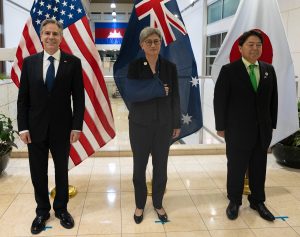In the Indo-Pacific region, the escalating geopolitical tensions prompted by China’s assertive challenge to the rules-based international order have catalyzed a novel approach among states. This has manifested in the expansion of high-level and technical relationships across states, governments, militaries, and advanced technology sectors.
Minilateral groupings present a more efficient and adaptable mechanism for addressing these complex challenges than traditional multilateral frameworks. Typically characterized by their limited size, reliance on trust, and interconnected networks, these groups operate on a foundation of shared values and objectives concerning specific issues.
Minilateral arrangements, with their inherent expediency, have thus become particularly attractive to “secondary regional powers” – states that are neither “great powers” nor “superpowers” – because of their manageability, voluntary nature, leader-focused orientation, and regional scope. Such frameworks align well with the strategic needs of these secondary powers, providing enhanced agency within an increasingly volatile and unpredictable security environment, where traditional multilateral bodies fall short in accommodating flexible hedging strategies.
Notable emerging minilaterals in this context include the Quad (Australia, Japan, India, and the United States), AUKUS (Australia, the United Kingdom, and the U.S.), the Trilateral Strategic Dialogue (Australia, Japan, and the U.S.), the Japan-South Korea-U.S. trilateral, and, more recently, the Japan-Philippines-U.S. trilateral summit, among others.
The Limitations of the QUAD and AUKUS
Despite the Quad, AUKUS, and, more recently, Chip 4 indicating a growing inclination toward technological collaboration, the domestic and national interests of each country still dictate the political bandwidth and resources they can allocate to these minilateral ventures. In this regard, the Trilateral Strategic Dialogue (TSD) demonstrates fewer points of friction that could hinder practical collaboration due to the high strategic complementarity among its three member states, as evidenced by the grouping’s consistent but low-profile engagements.
The TSD, a strategic minilateral arrangement established over two decades, has developed significant institutionalization, encompassing defense intelligence, advanced technology capacity building, disaster management, training, and military exercises aimed at high-end warfighting interoperability. Over its 22-year history, the TSD’s commitment to regular meetings, discussions, strategizing, and information sharing has fostered a consistent high-level interaction that transcends broader notions of “like-mindedness,” as seen in the Quad. Consequently, some analysts propose that the TSD functions as the “inner core” of coordination among the U.S., Japan, and Australia in the face of strategic competition in the Indo-Pacific.
It is crucial to understand that integrating strategic AI collaboration within the TSD extends beyond mere optimization of collaborative efforts or enhancing high-level alignment across strategic innovation areas. Addressing AI capability gaps, as well as future workforce and machine learning data training needs, can be effectively managed, networked, and scaled through collective efforts based on shared interests.
Japan, as a leading state in AI innovation, plays a pivotal role in these endeavors, contributing strategically and mutually toward these goals. Its potential to act as a force multiplier to joint efforts already underway by the United States and Australia in AUKUS, particularly in the domain of AI, should be a central consideration.
The State of Trust
It is pertinent to note that the United States perceives Australia and Japan not only as responsible treaty allies but also as its most like-minded and capable regional partners. For Japan, while the U.S. remains the primary strategic partner, Australia has emerged as a close second. In Canberra, these sentiments underscore the momentum achieved through the TSD platform, despite occasional irregular meetings, and the synergy reflected in documents such as Australia’s 2023 Defense Strategic Review, Japan’s 2022 National Security Strategy, and the U.S. Indo-Pacific Strategy.
Established patterns of cooperation, dialogue, and shared security narratives have expanded trust networks, shaped appropriate cultural, political, and regulatory behaviors, and enhanced cross-border exchanges more effectively than frameworks like the Quad or AUKUS can currently achieve. Japanese analysts, as noted by Thomas Wilkins, suggest that the TSD “creates a safe space through which Japan can acclimate itself with familiar allies and partners, particularly as it adapts to the implications of its new defense policy settings, which may appear less threatening when operationalized collaboratively.”
Sharing Across the AI Domain
In the domain of sensitive technology sharing across the AI spectrum – encompassing machine learning, algorithm and hardware accelerators, natural language processing, data analytics, and integrated circuit design – the TSD’s intimacy provides a ready-made platform for AI collaboration. This distinguishes the TSD from other minilaterals, which may employ more routine policy instruments or include partners with less developed institutional processes and experience.
As Kei Koga highlights, the success of strategic minilaterals hinges on their ability to “develop an optimal division of labor” in achieving outcomes. In frameworks lacking deep consensus, the absence of such arrangements can constrain the capacity to undertake hard security initiatives. Compared to the Quad, the formal alliance partnerships of Japan and Australia with the United States offer greater flexibility for exploring sensitive policy areas within a trilateral context. Such formalized agreements facilitate effective coordination, realignment of resources, and strategic goal accomplishment due to established roles and expectations.
Overall, existing bilateral strategic partnerships between all three members have grown over time to work as “building blocks” for deepening TSD interaction. These include not simply military exercises and bilateral ministerial meetings, but also examples like the Japan-Australia Agreement on the Transfer of Defense Equipment and Technology, and enhanced acquisition and cross-servicing agreements, as well as Reciprocal Access Agreements, across all three countries.
During the historic Japan-U.S. summit held in April 2024, U.S. President Joe Biden and Japanese Prime Minister Kishida Fumio signaled more collaboration among TSD members toward the creation of a joint air defense network to deepen interoperability and defense planning. With the enforcement of the Japan-Australia Reciprocal Access Agreement in 2023, the building blocks for creating an integrated air and missile defense system are present. It also offers another milieu to expand cooperation among the three countries altogether, including critical and emerging technologies like AI.

































